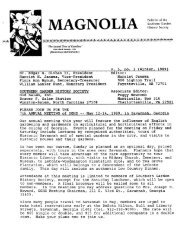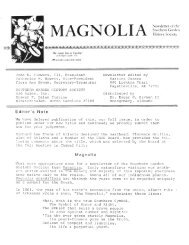Vol. XII, no. 2, 3 & 4 - Southern Garden History Society
Vol. XII, no. 2, 3 & 4 - Southern Garden History Society
Vol. XII, no. 2, 3 & 4 - Southern Garden History Society
You also want an ePaper? Increase the reach of your titles
YUMPU automatically turns print PDFs into web optimized ePapers that Google loves.
. <strong>no</strong>n<br />
.e<br />
by Michael T. Trostel, Baltimore, Maryland<br />
Great Georgia n<br />
Houses of<br />
America ,<br />
<strong>Vol</strong>. 1, Kalkhof<br />
Press, New York ,<br />
1933, p. 173<br />
-<br />
indige<strong>no</strong>us) plants began in the early seventeenth century, wit h<br />
Holland taking the lead. Their gardening books, translated into<br />
German, French, and English with "how-to" illustrations, helpe d<br />
spread the development of orangeries . Orangeries were calle d<br />
"greenhouses" until the middle of the nineteenth century becaus e<br />
they were used to keep plants green, such as orange and lemo n<br />
trees, that would otherwise die if left out of doors all year .<br />
The Whole Art of Husbandry, published<br />
in London in 1631 by Gervase Markham ,<br />
described an embryo form of an orangery .<br />
In 1649, Queen Henrietta Maria's oranger y<br />
at Wimbleton was listed in a Parliamentar y<br />
Survey of the ma<strong>no</strong>r as containing forty-tw o<br />
orange trees that were valued at ten pounds<br />
each — a huge sum in 1649 .<br />
In the late seventeenth century<br />
numerous orangeries were constructe d<br />
throughout England. These early examples<br />
were tall, relatively narrow buildings wit h<br />
large windows on their south elevations .<br />
The usual heat source was charcoal place d<br />
in a pit in the floor or in a brazier or an iro n<br />
stove . In the 1690s, a much improved<br />
heating system was developed for th e<br />
orangery at the Chelsea Physic <strong>Garden</strong> . A<br />
below-grade-level stove supplied heat t o<br />
underfloor ducts . This basic system<br />
continued in use for the next century . In<br />
some examples, the heat ducts were also<br />
built into the <strong>no</strong>rth wall of the orangery .<br />
Page 2 Calendar<br />
Page 7 SGHS Annual Meeting<br />
Page 10 In Print<br />
Page 11 Journal of <strong>Garden</strong> <strong>History</strong> Publications<br />
Continued on page 2 . . .<br />
Serious interest in protecting tender or exotic (i
















